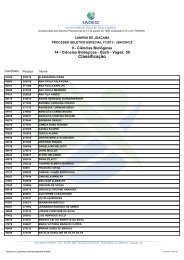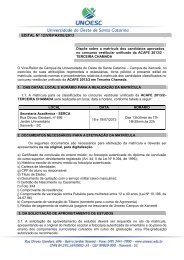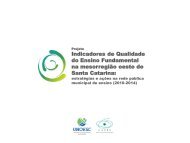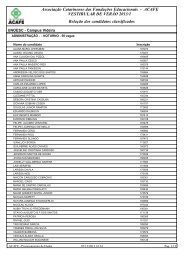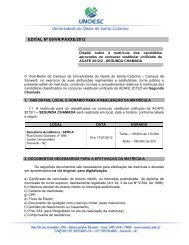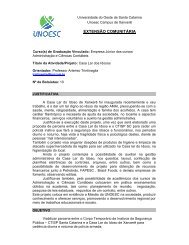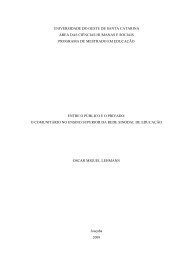Anais do I Congresso de Bioetica e Bem-Estar Animal - Unoesc
Anais do I Congresso de Bioetica e Bem-Estar Animal - Unoesc
Anais do I Congresso de Bioetica e Bem-Estar Animal - Unoesc
Create successful ePaper yourself
Turn your PDF publications into a flip-book with our unique Google optimized e-Paper software.
<strong>Anais</strong> <strong>do</strong> I <strong>Congresso</strong> Brasileiro <strong>de</strong> Bioética e <strong>Bem</strong>-<strong>Estar</strong> <strong>Animal</strong> e<br />
I Seminário Nacional <strong>de</strong> Biossegurança e Biotecnologia <strong>Animal</strong><br />
Greenfield e colabora<strong>do</strong>res analisaram <strong>do</strong>is grupos <strong>de</strong> estudantes, quan<strong>do</strong> o grupo<br />
I recebeu o seu treinamento com animais vivos e o grupo II com mo<strong>de</strong>los alternativos. A<br />
análise <strong>do</strong>s resulta<strong>do</strong>s mostrou que não houve diferença significativa entre os <strong>do</strong>is grupos<br />
(GREENFIELD et al., 995b).<br />
A implantação <strong>de</strong> méto<strong>do</strong>s como o estu<strong>do</strong> <strong>de</strong> procedimentos cirúrgicos em<br />
cadáveres vem aumentan<strong>do</strong> no ensino da medicina veterinária <strong>de</strong> diversas universida<strong>de</strong>s.<br />
O aproveitamento <strong>do</strong>s cadáveres <strong>de</strong> animais que vieram a óbito nos hospitais veterinários<br />
tem contribuí<strong>do</strong> para acabar com a eutanásia para fins didáticos e para aumentar a aceitação<br />
<strong>do</strong> méto<strong>do</strong> pelos acadêmicos (DUFFEE, 999).<br />
Nas 27 faculda<strong>de</strong>s <strong>de</strong> medicina veterinária <strong>do</strong>s Esta<strong>do</strong>s Uni<strong>do</strong>s foram eutanasia<strong>do</strong>s<br />
6.655 animais em aulas práticas no perío<strong>do</strong> <strong>de</strong> 983 a 984. Atualmente, quase todas as<br />
faculda<strong>de</strong>s <strong>de</strong> veterinária <strong>do</strong> Canadá e <strong>do</strong>s Esta<strong>do</strong>s Uni<strong>do</strong>s possuem méto<strong>do</strong>s alternativos para<br />
minimizar o uso <strong>de</strong> animais vivos para o treinamento <strong>do</strong>s alunos (BALCOMBE, 2000).<br />
Em 200 a Universida<strong>de</strong> da Califórnia – Davis <strong>de</strong>ixou <strong>de</strong> utilizar animais vivos nas<br />
aulas práticas <strong>de</strong> cirurgia. Segun<strong>do</strong> John Pascoe (200 ), Diretor da referida Universida<strong>de</strong>,<br />
<strong>de</strong>vi<strong>do</strong> às modificações no ensino, às alterações realizadas na meto<strong>do</strong>logia <strong>de</strong> ensino, a<br />
faculda<strong>de</strong> contratou mais instrutores e diminuiu o número <strong>de</strong> alunos por aula prática, para<br />
que eles possam ter melhor supervisão e aprendiza<strong>do</strong>.<br />
As mudanças no ensino só <strong>de</strong>pen<strong>de</strong>m <strong>do</strong> empenho e da consciência <strong>do</strong>s <strong>do</strong>centes<br />
que ministram as disciplinas. Assim, po<strong>de</strong>-se concluir dizen<strong>do</strong> que as aulas <strong>de</strong> Técnica<br />
Cirúrgica e Ortopedia na FMVZ/USP sofreram um avanço ético, pelo respeito aos animais<br />
e aos seus alunos também, pois anualmente eram eutanasia<strong>do</strong>s 300 cães para aten<strong>de</strong>rem<br />
à disciplina <strong>de</strong> Técnica Cirúrgica. Hoje utilizamos 50 cadáveres para ministrar as aulas<br />
práticas das duas disciplinas referidas.<br />
REFERÊNCIAS BIBLIOGRÁFICAS<br />
BALCOMBE, J. The use of animals in higher education: problems, alternatives and<br />
recommendations. Washington. The Humane Society Press, 2000, p. 04.<br />
BAUER,M.S.; SEIM, H.B. Alternative Methods to Teach Veterinary Surgery. Humane<br />
Innovations and Alternatives, p.40 -404, 993.<br />
BAUER,M.S. A survey of the use of live animals, cadavers, inanimate mo<strong>de</strong>ls, and<br />
computers in teaching veterinary surgery. Journal American Veterinary Medical<br />
Association, v.203, n.7, p. 047- 05 , 993.<br />
CARPENTER,L.G.; PIERMATTEI,D.L.; SALMAN,M.D.; ORTON,E.C.; NELSON,A.<br />
W.; SMEAK,D.D.; JENNINGS JR,P.B.; TAYLOR,R.A. A comparison of surgical<br />
training with live anesthetized <strong>do</strong>gs and cadavers. Veterinary Surgery, v.20, n.6, p.373-<br />
378, 99 .<br />
DUFFEE, N. Alternative training methods I; Proceedings of the 998.<br />
GREENFIELD, C.L.; JOHNSON, A.L.; ARENDS, M.W.; WROBLEWSKI,A.J.<br />
Development of parenchimal ab<strong>do</strong>minal organ mo<strong>de</strong>ls for use in teaching veterinary Soft<br />
Tissue Surgery. Veterinary Surgery, v.22, n.5, p.357-362, 99 .<br />
Sistema CFMV/CRMVs - Comissão <strong>de</strong> Ética, Bioética e <strong>Bem</strong>-<strong>Estar</strong> <strong>Animal</strong> e Comissão <strong>de</strong> Biotecnologia e Biossegurança<br />
99



